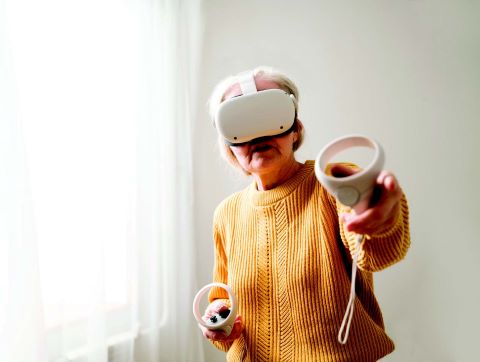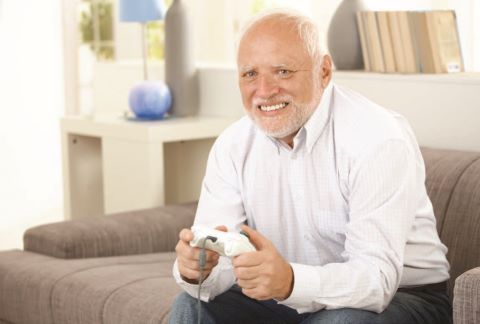Should Your Facility Invest in Gaming?
Get a glimpse of a near future where resident activities turn virtual. People of all ages can now use portable electronic games on smartphones or tablets to exercise their brains, but as technology expands, the virtual possibilities seem endless — and more accessible. Some gaming-specific consoles even allow players to move their bodies to bowl, golf, or dance. May physicians start prescribing screentime for their older patients? “As a healthcare professional with an older adult focus, I’m constantly talking about not just the importance of physical activity, social engagement, and intellectual/mental stimulation, but also helping my patients to access these pillars of health in ways that are meaningful to them,” says Christopher J. Norman, MSN, APRN, APHN-BC, AGPCNP-BC, GNP-BC, geriatric nurse practitioner, gerontologist, and advanced practice holistic nurse of Program of All-Inclusive Care for the Elderly of Central New York (PACE CNY) in East Syracuse, New York. Realize a More Tech-Savvy Generation Approaches Retirement A 2019 AARP study found the number of adults age 50 and older who play video games increased from 40.2 million people in 2016 to 50.6 million people in 2019. When you factor in there were approximately 94.5 million Americans age 55 and older in 2019, the video game-playing population accounts for about 50 percent of the public. Regardless of whether older adults enjoy playing puzzle games on their tablet or are out of their chair and using movement to play games with their friends or grandchildren, many adults are reaping the benefits of improving their mind and physical fitness. “I think video games that incorporate movement, group engagement, and thought provocation have a real place in an older person’s health practices,” Norman adds. Use Video Games to Boost Brain Function and Train Bodies Researchers at the University of California San Francisco (UCSF) published a study in August 2022 which explored the effects of a motion-capture video game on the cognitive abilities and physical fitness of older adults. Participants of the study were 49 older adults, whose average age was 68 years old. The researchers designed a closed-loop video game, called Body-Brain Trainer (BBT), which participants operated using motion-capture technology. The technology required the participants to move their body to control the onscreen action instead of pressing buttons on traditional handheld video game controllers. By using a closed-loop design, the researchers were able to tailor the training experience to each participant. “This makes the challenge that one experiences during training more precise, and more fun by having the game play at an appropriate level,” says Joaquin A. Anguera, PhD, associate professor and director of clinical program at Neuroscape, University of California San Francisco. During the two-month study, participants in the variable group played the BBT game and had their performance evaluated across the game’s three modules: Researchers saw improvements in the older adults’ physical fitness through blood pressure and balance, as well as improved attention. After training with BBT, the researchers compared the results of the older adults to the performance of an untrained group of 20-year-old adults. In comparison, the older adults performed better in the game modules. The researchers also noted that while the older adults did perform better than the younger adults with the modules after training, the two age groups started the study similarly. “It’s important to note that even with improvements seen by the older adults, there was actually no difference between the groups at baseline,” Anguera adds. Additionally, the improvement observed by the BBT group during the study wasn’t solely due to repeated practice, “but something reflecting an actual change in sustained attention abilities as the control group didn’t show such an effect,” Anguera says. Envision a Future With Gaming Rx Could motion-based video games, such as BBT, gain similar acceptance for treatment where physicians could prescribe the alternative therapy for older patients? Experts seem to agree that using these types of games could be helpful in a care plan to slow cognitive decline. “Speaking for myself, I do see the potential for this. Studies like this give hints that this could be a possibility for stemming off cognitive decline and/or preserving one’s quality of life,” Anguera says. Adam Gazzaley, MD, PhD, founder and executive director of Neuroscape, at the University of California San Francisco, and one of the authors of the study, agreed with the future possibility of video games for treatment. “I can’t help but make the comparison to technology that came out of Neuroscape and has now become treatment for ADHD [attention-deficit/ hyperactivity disorder],” Gazzaley says. In 2020, the U.S. Food and Drug Administration (FDA) approved EndeavorRx as a treatment for ADHD. The treatment is designed to help kids aged 8 to 12 years improve their attention function through an engaging, interactive video game on a mobile device. This was the first video game ever approved by the FDA for any medical condition. “I envision a future where tools such as BBT, which I consider type of Experiential Medicine, will be a part of the armamentarium available to medical practitioners. I also see a time where versions of these medicines are delivered to support wellbeing and flourishing for all individuals looking to improve their cognition,” Gazzaley added. The experts also agree that video games shouldn’t be the only healthcare option to preserving cognitive function and quality of life. Anguera added that the tools would be part of a treatment program for the patient’s health where the combination of the tools, sleep, exercise, family, spirituality, family, and a varied diet “that lead to the overall greatest outcomes.” 


